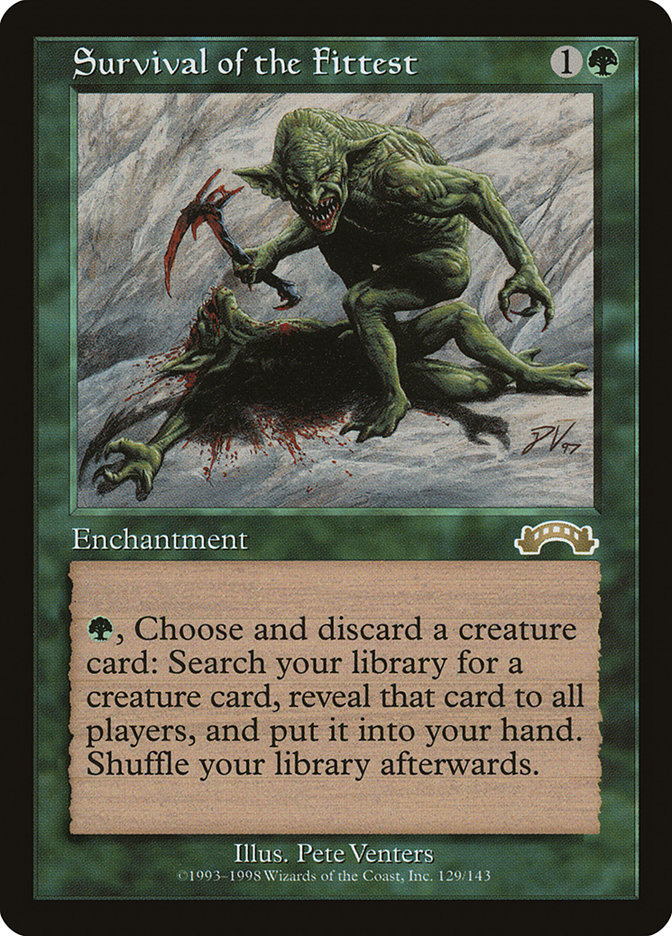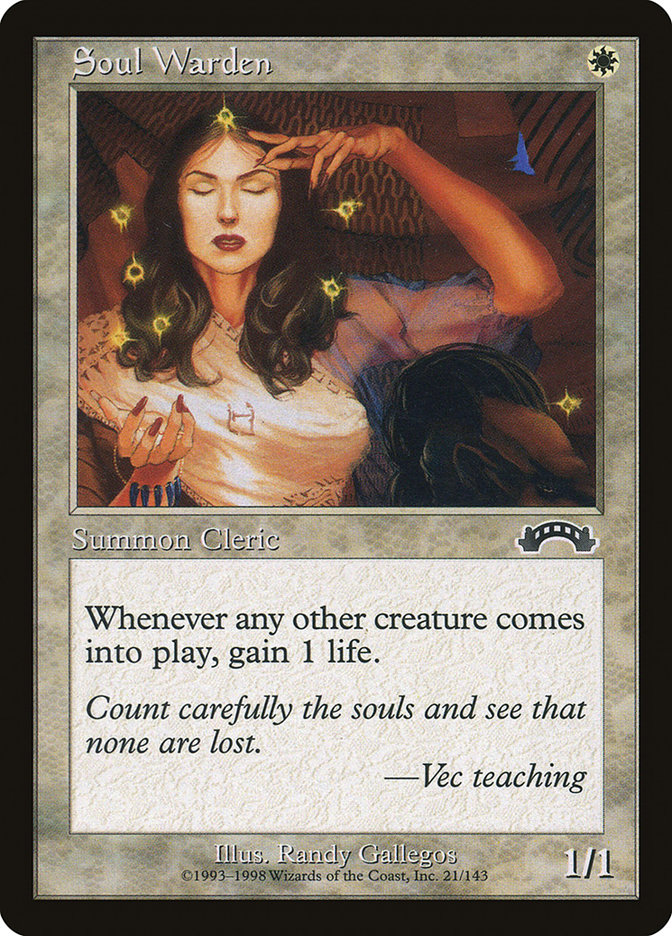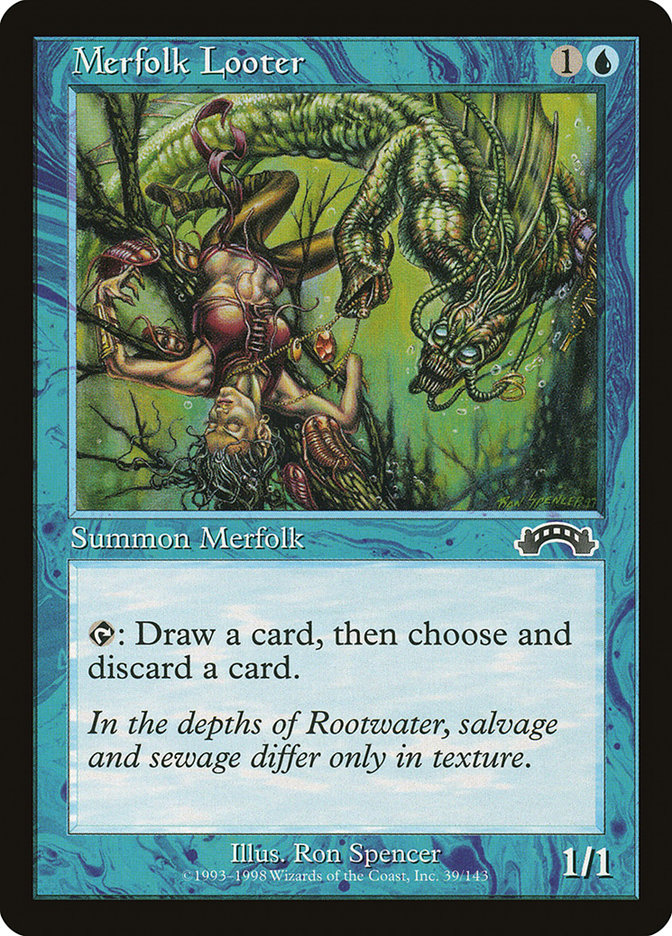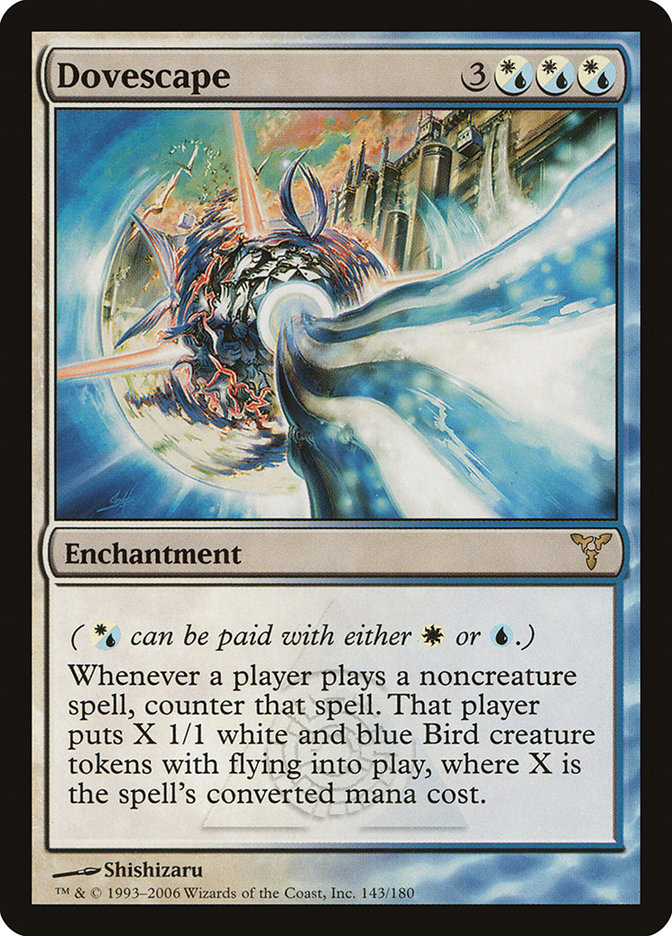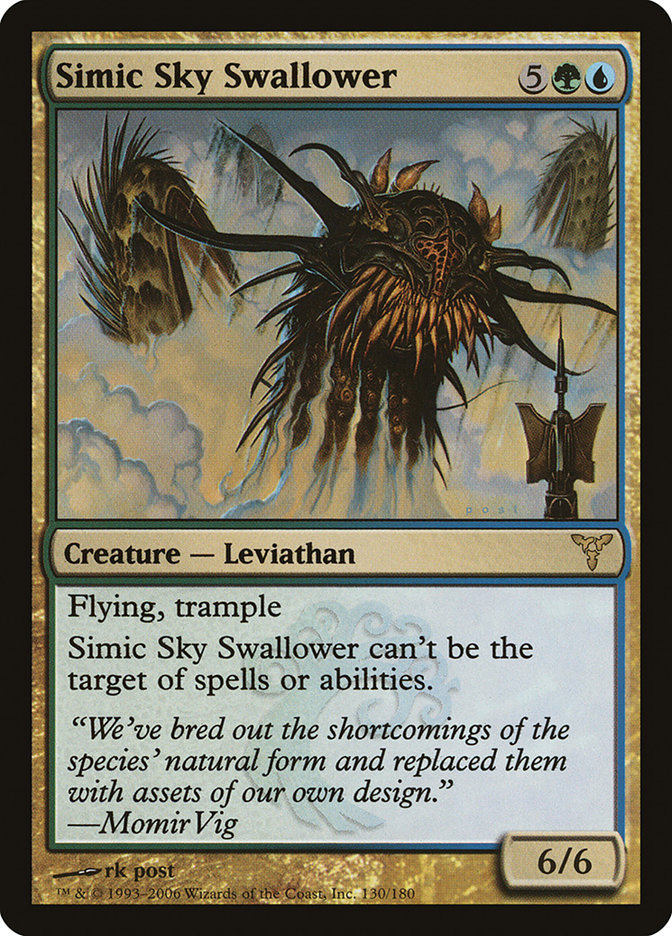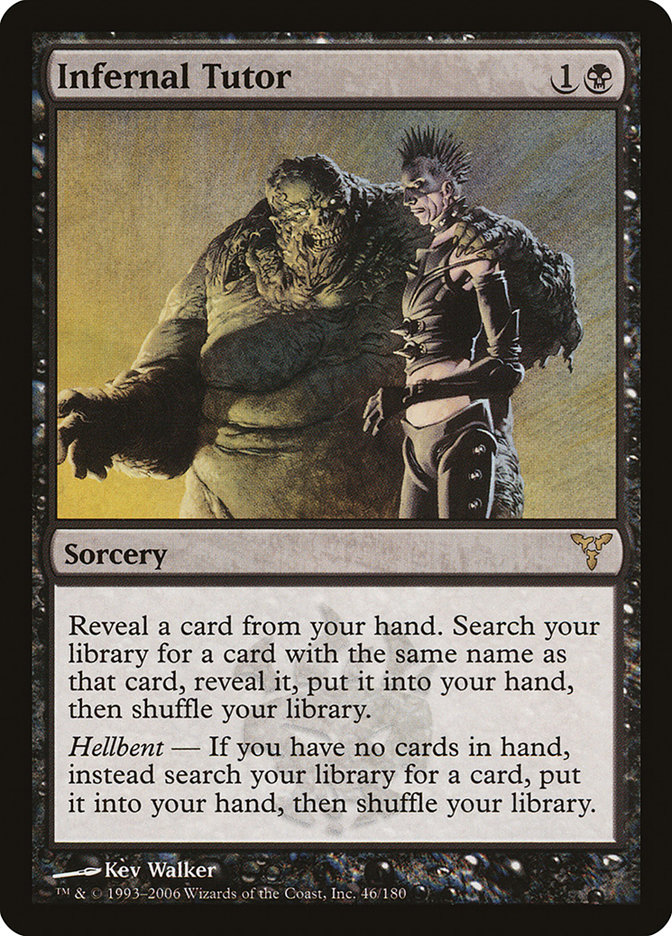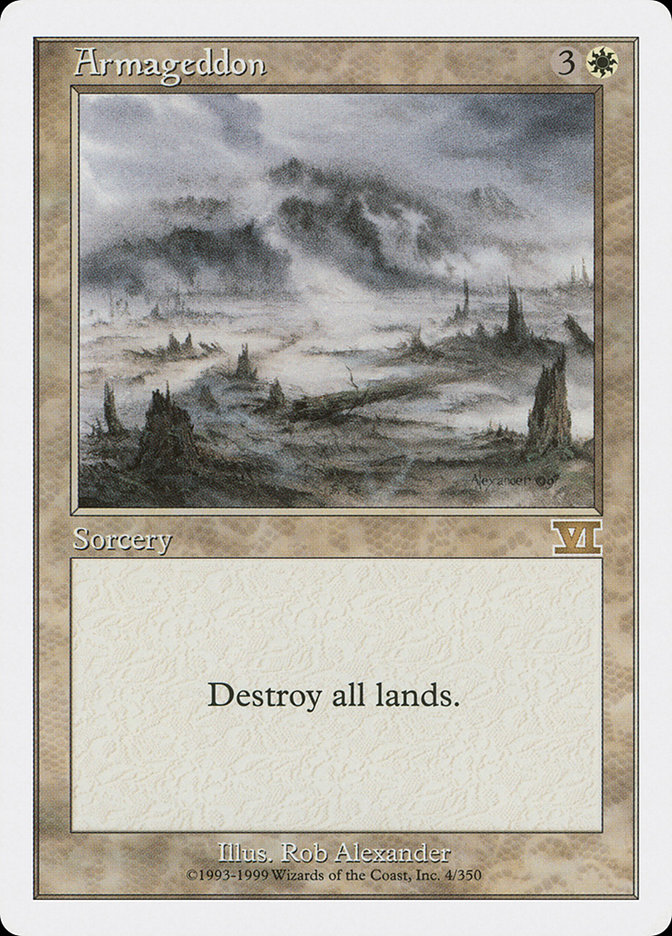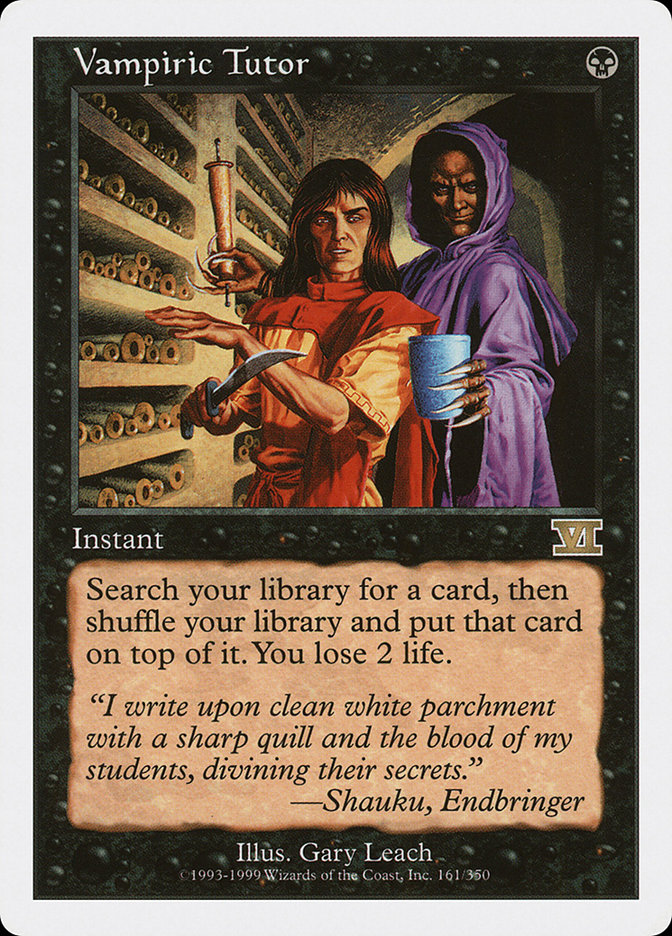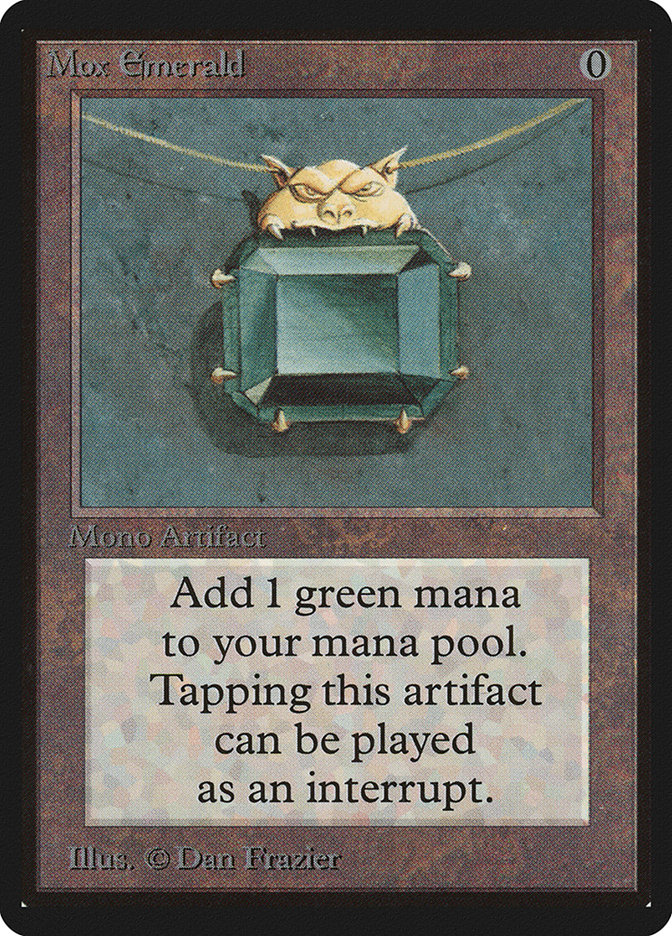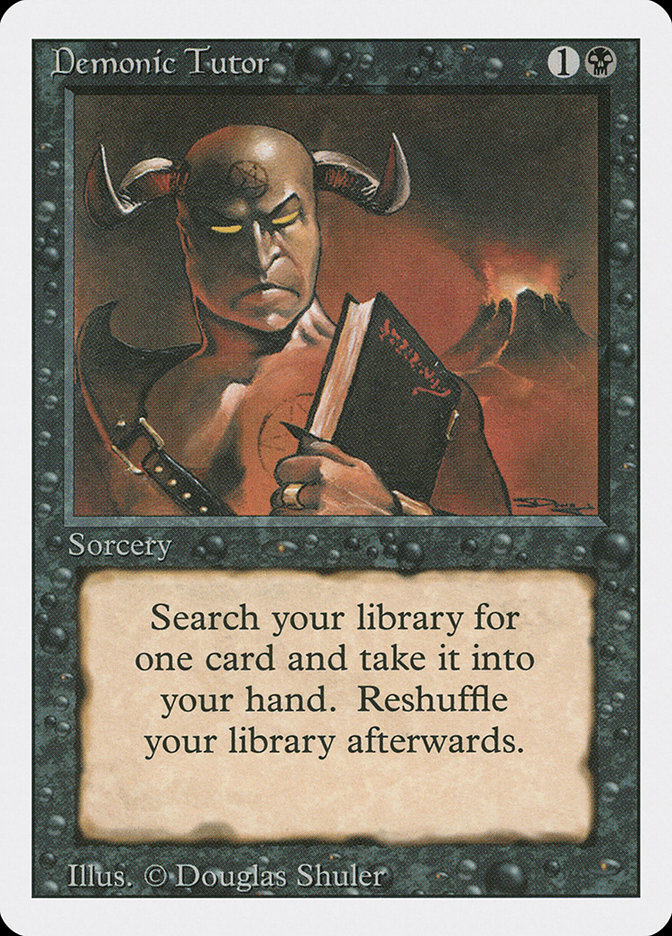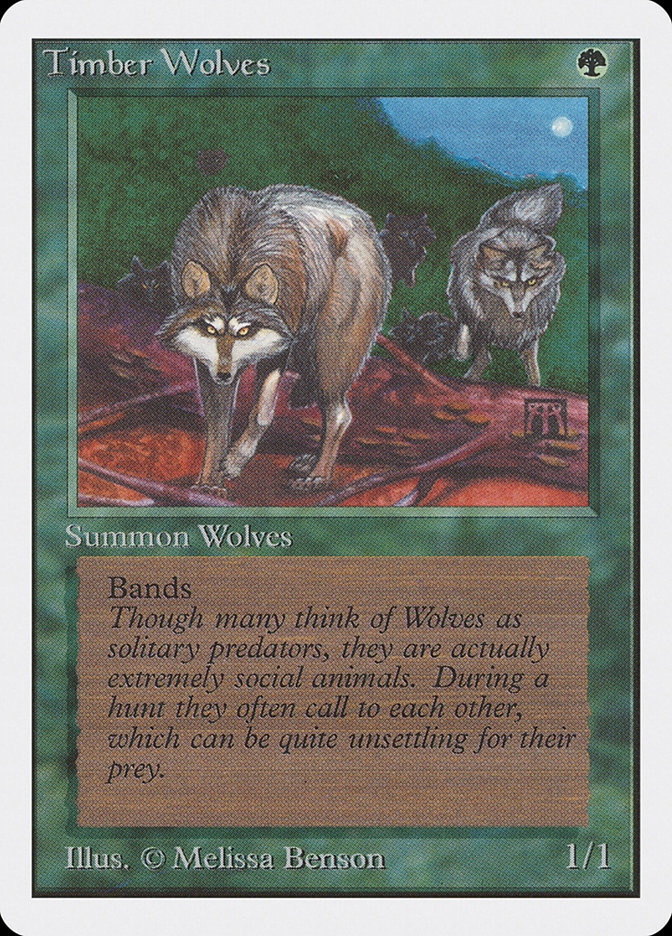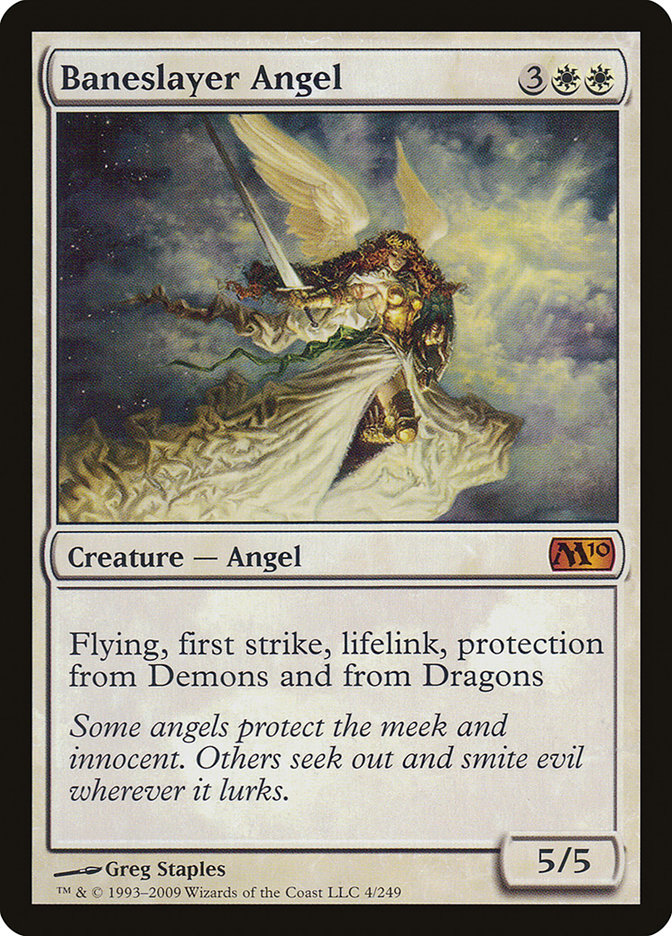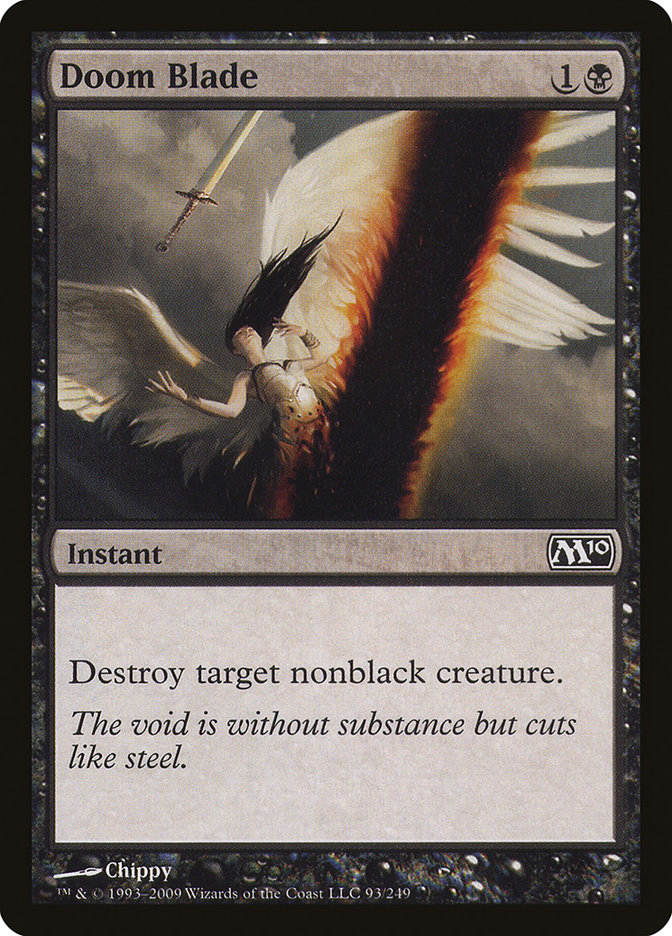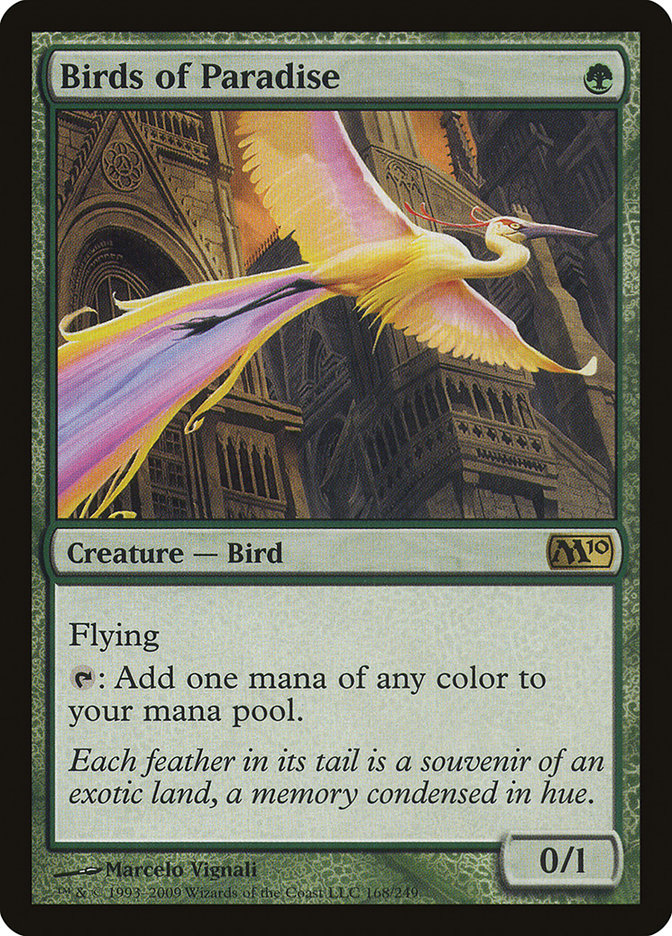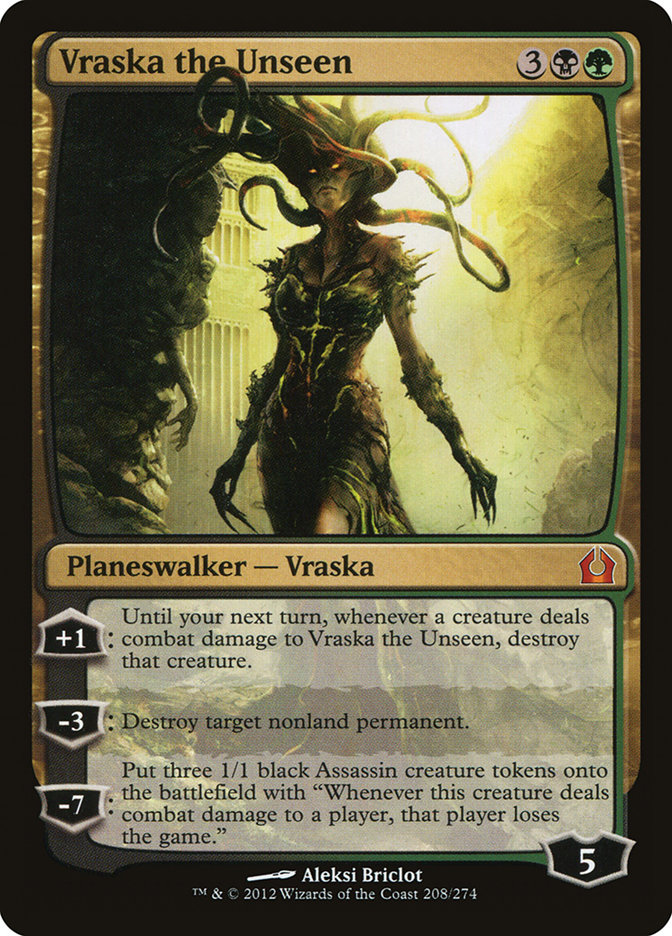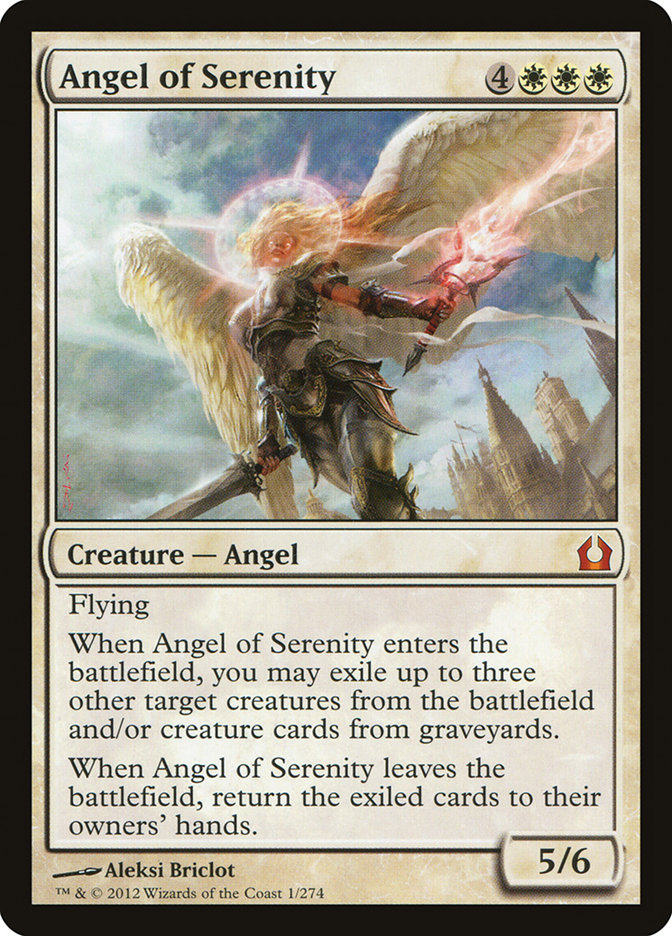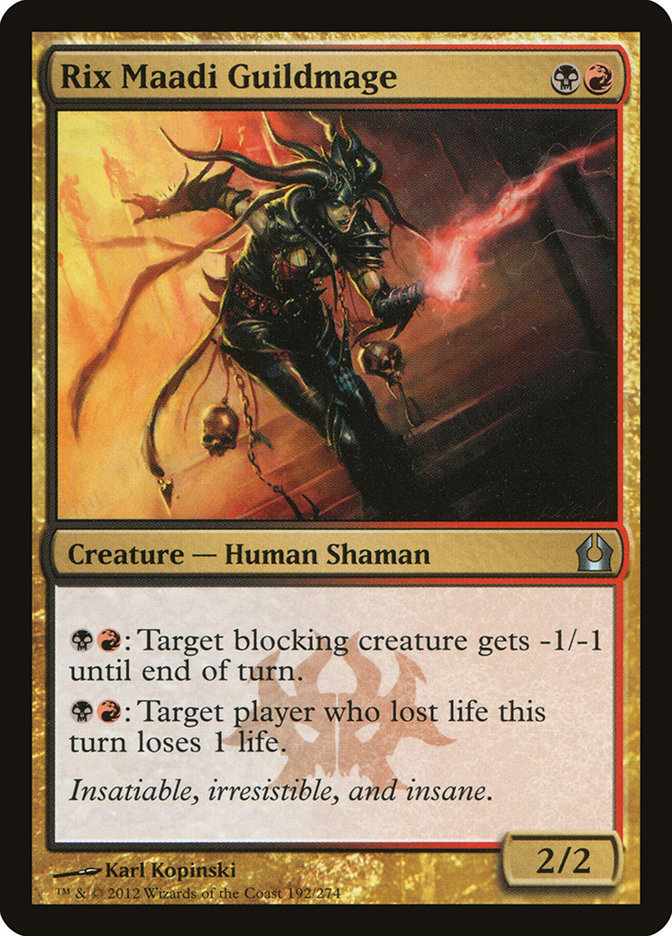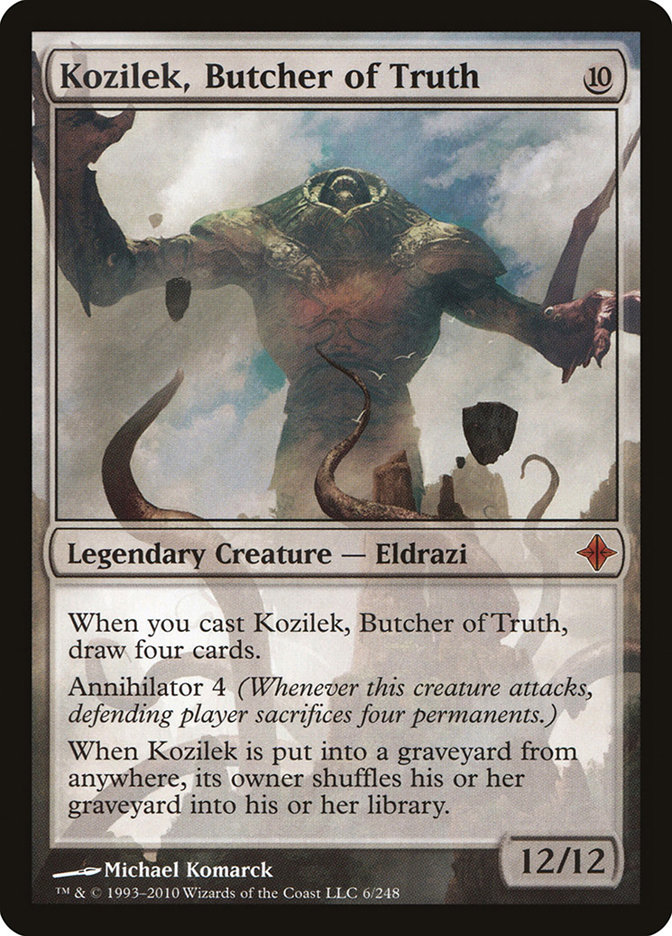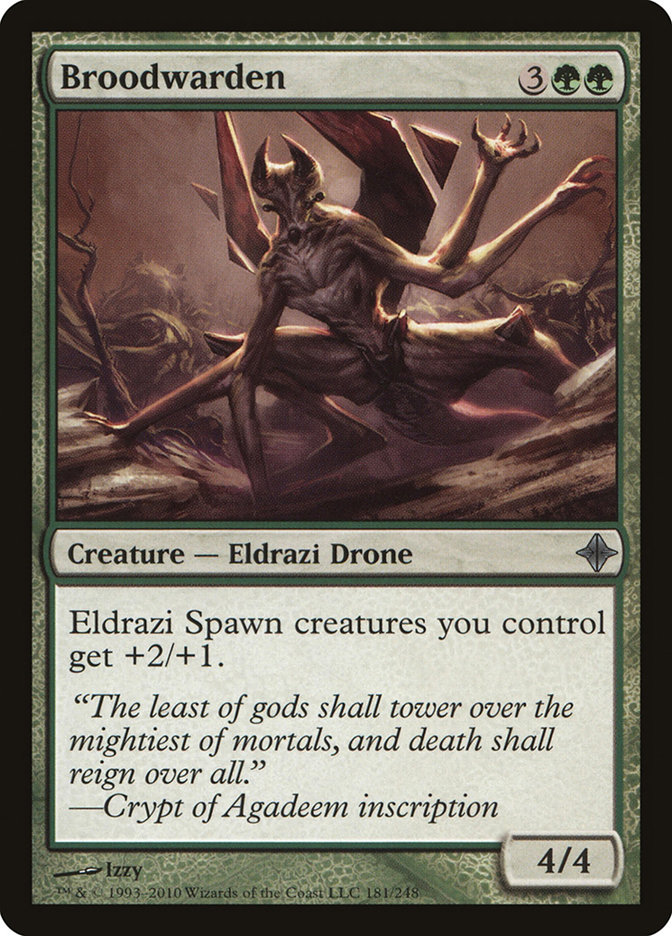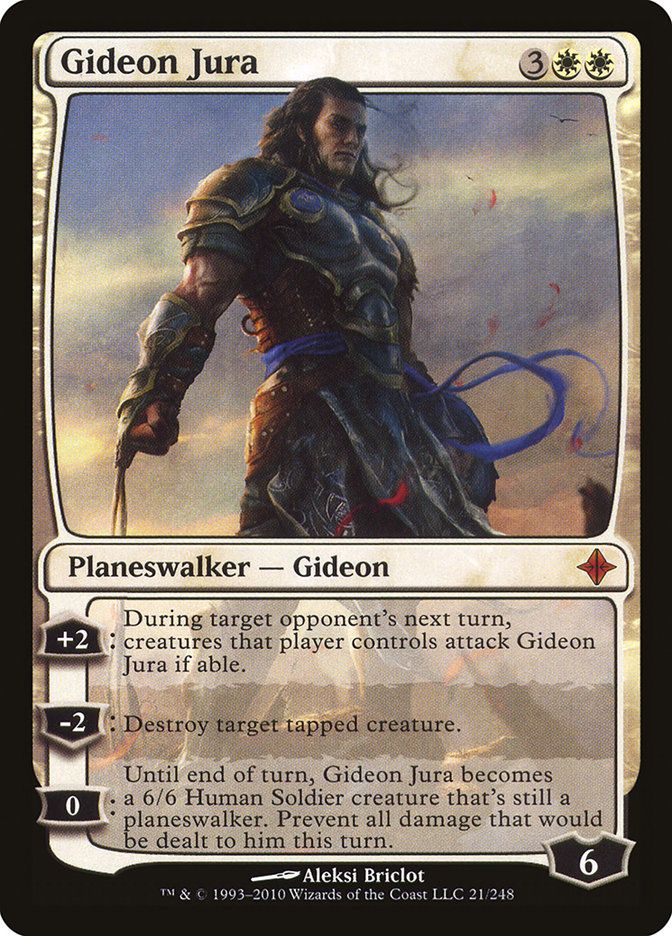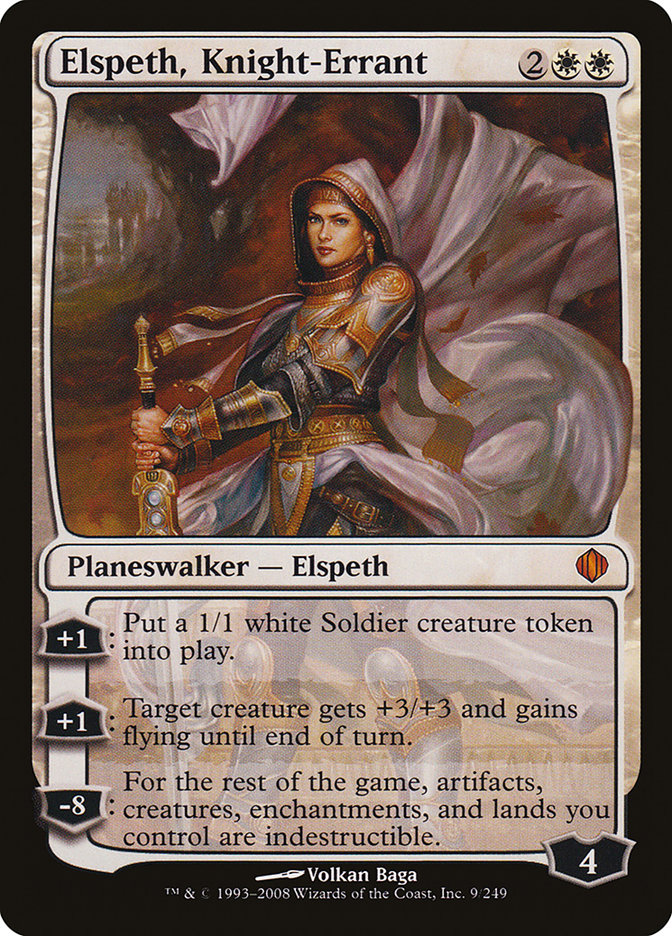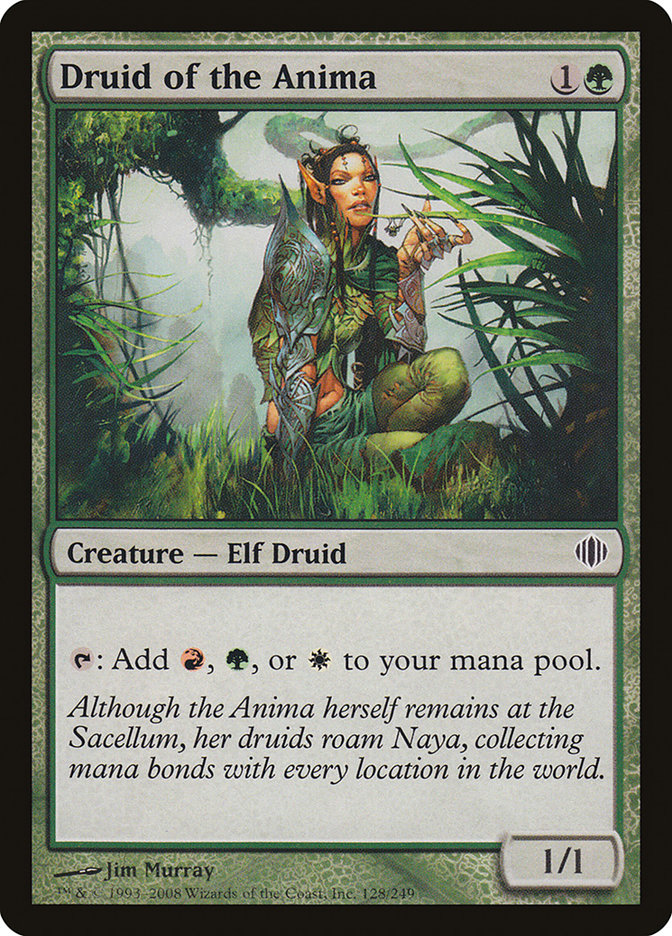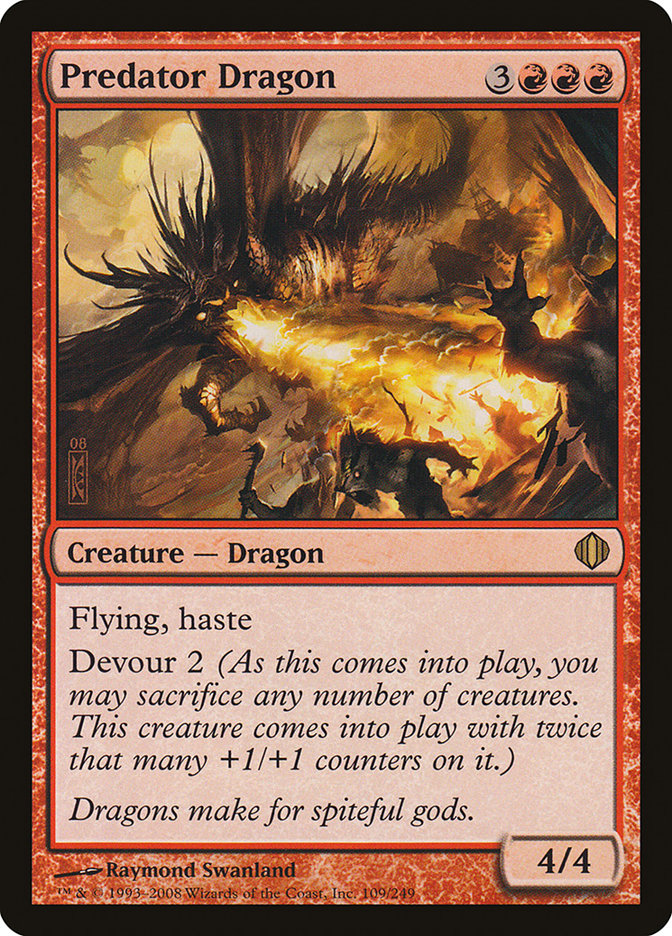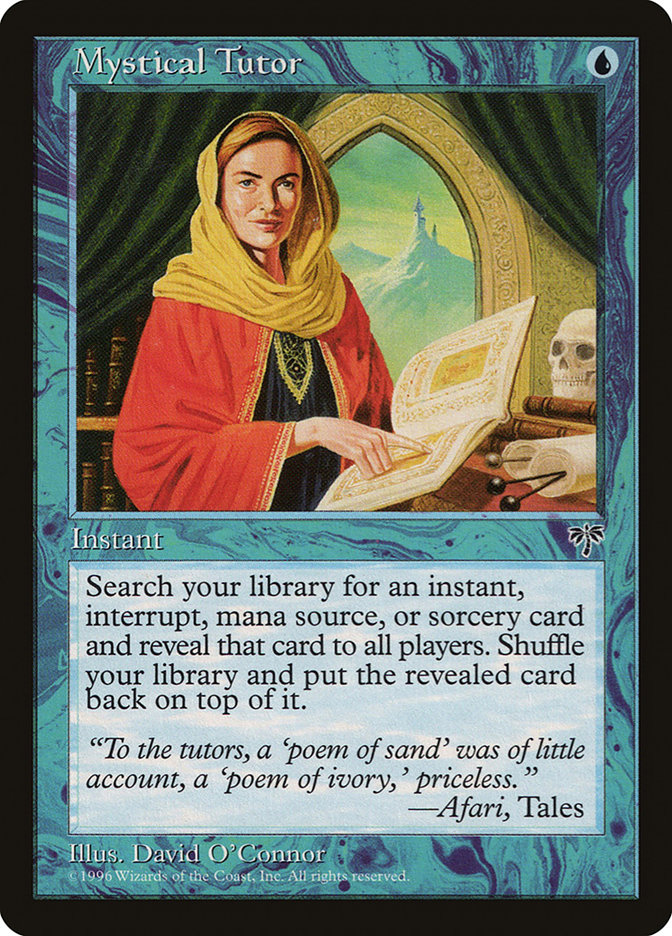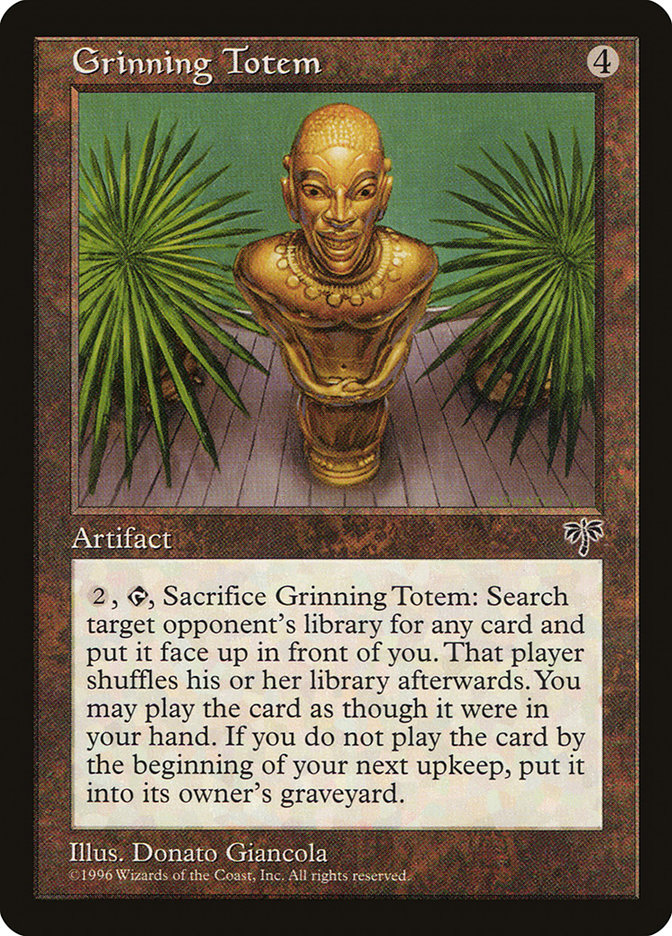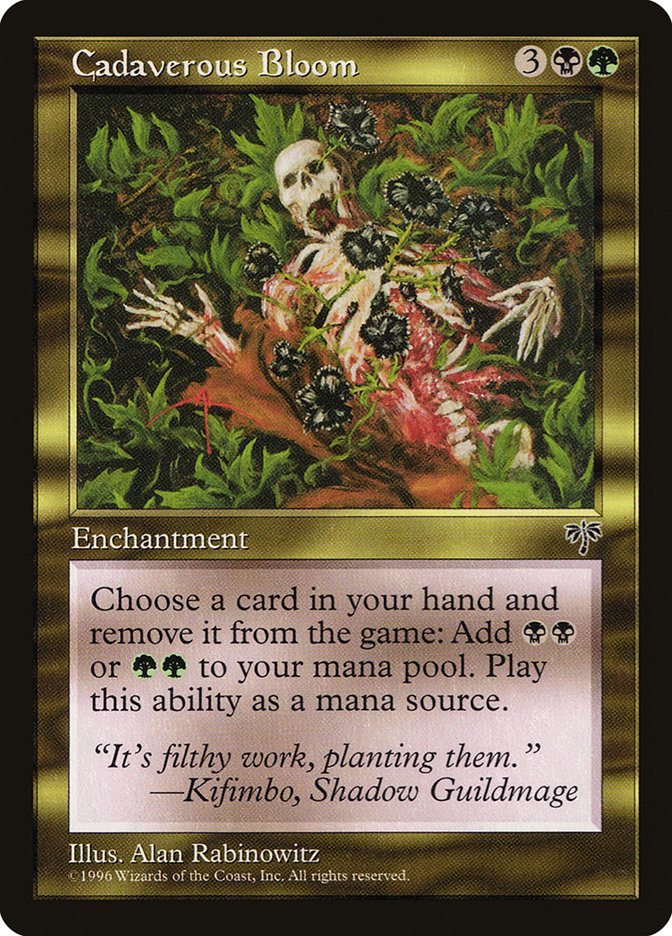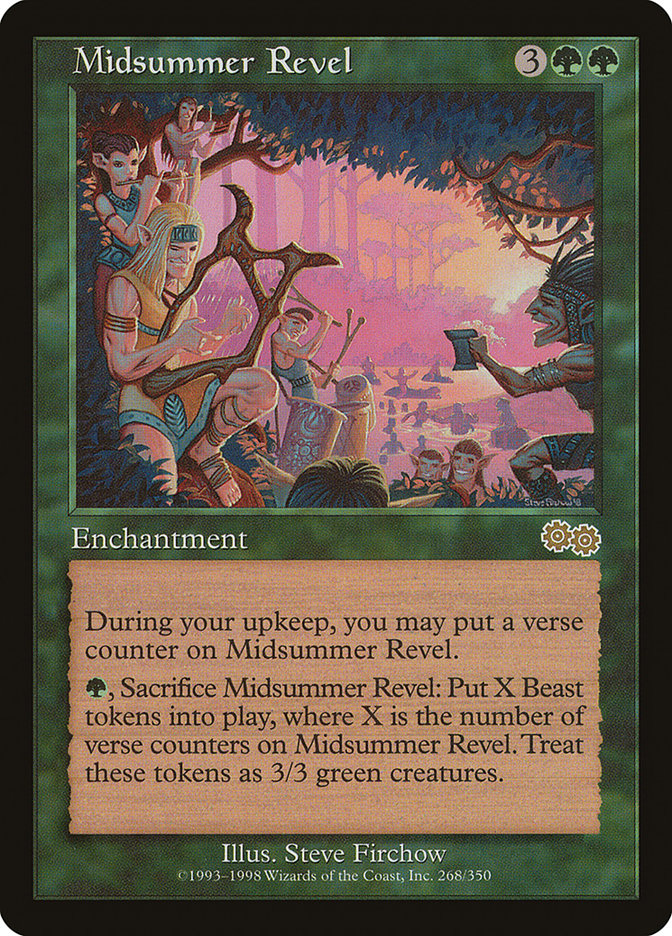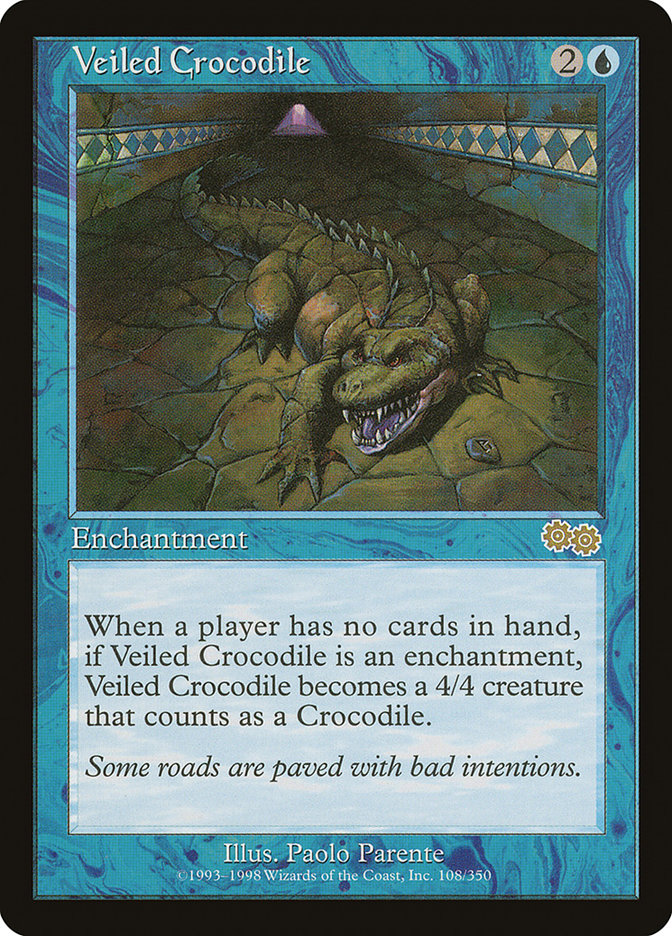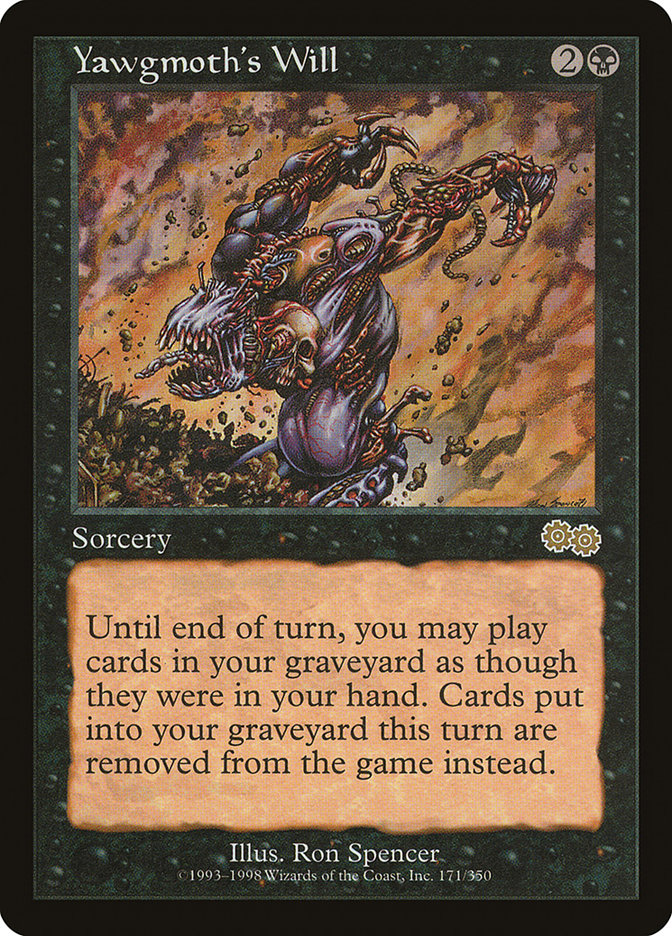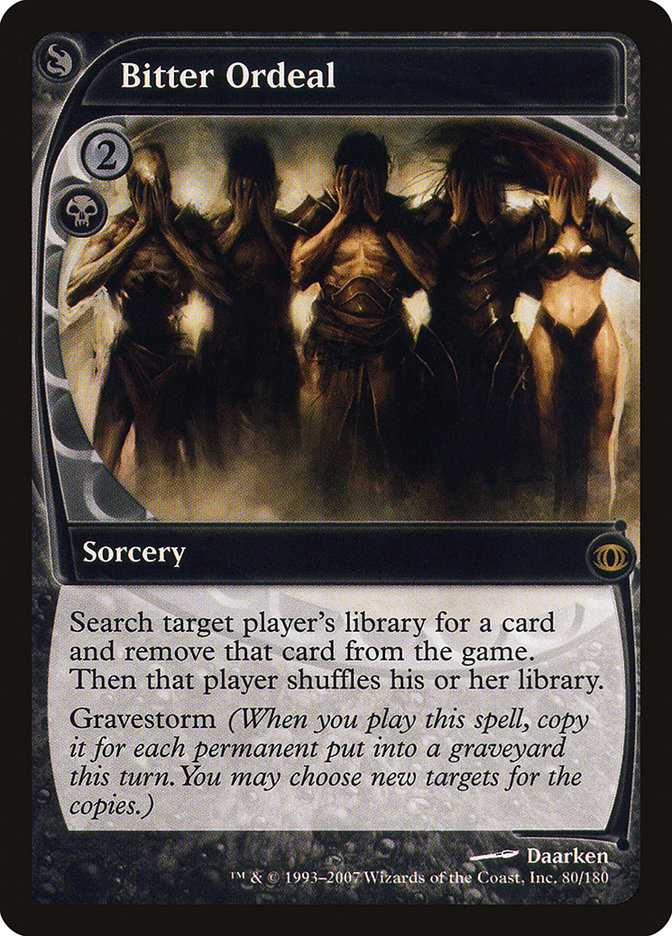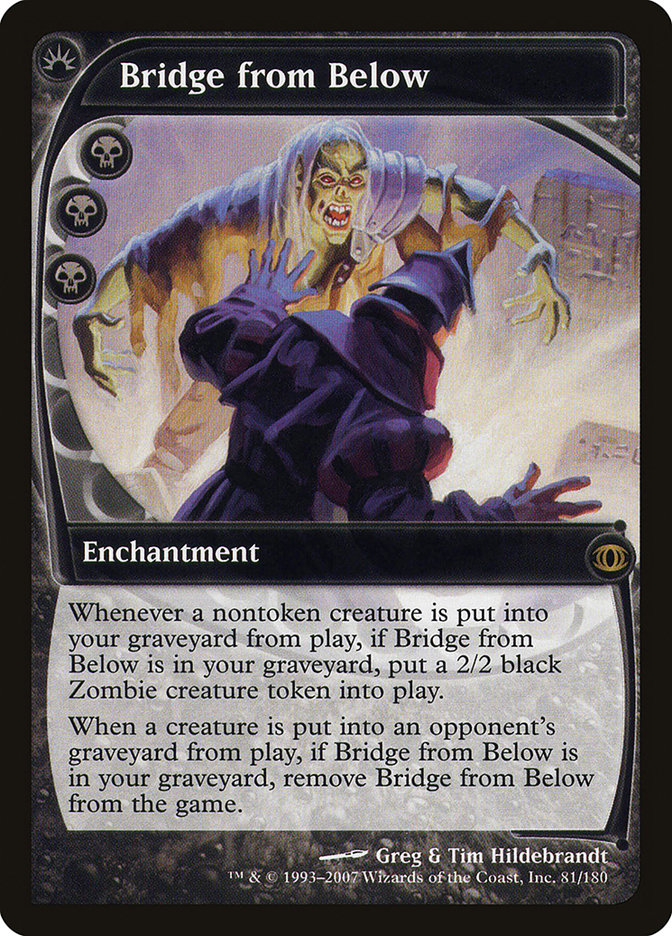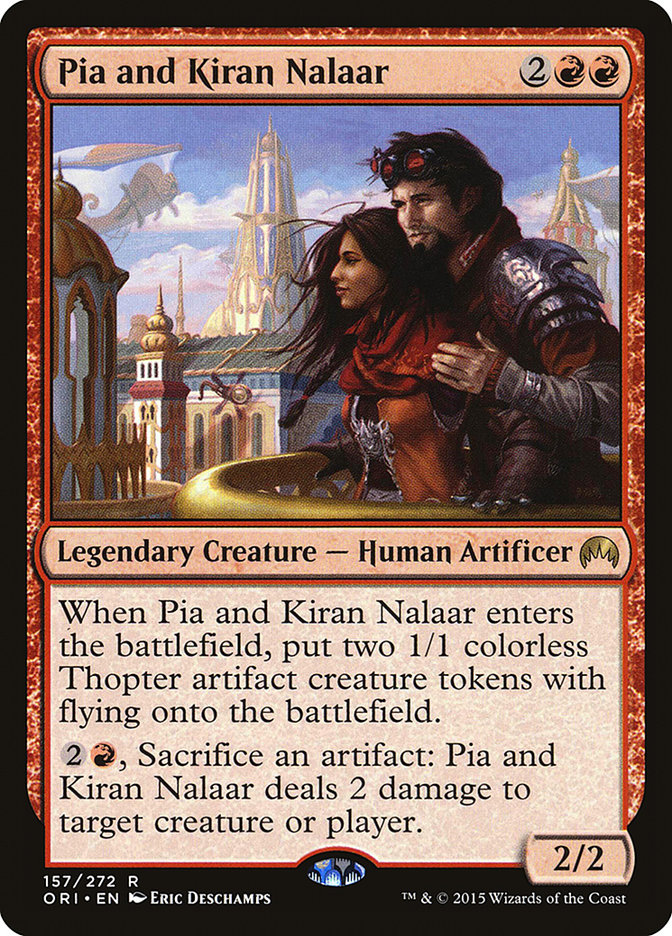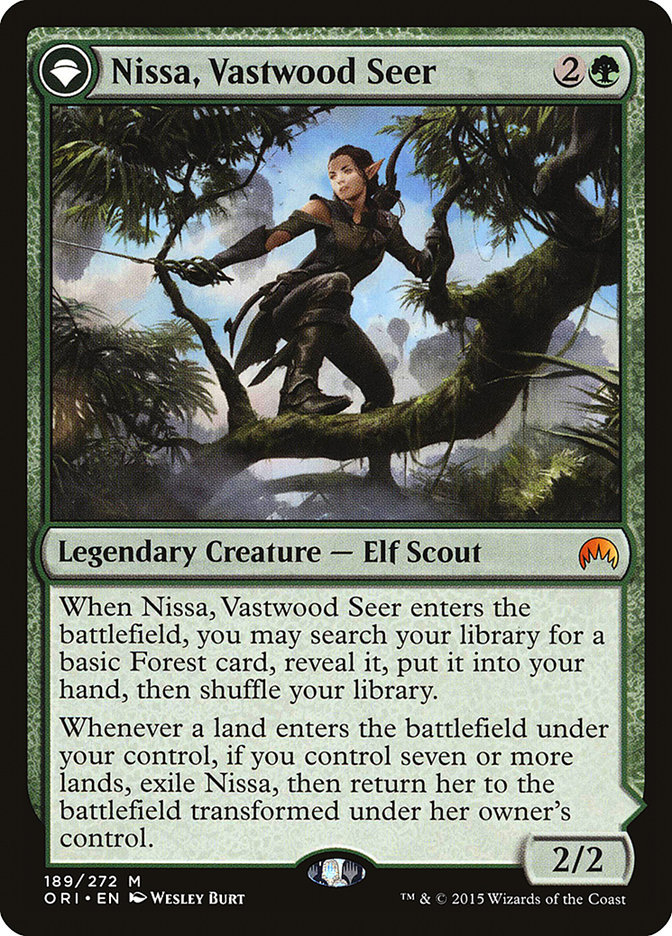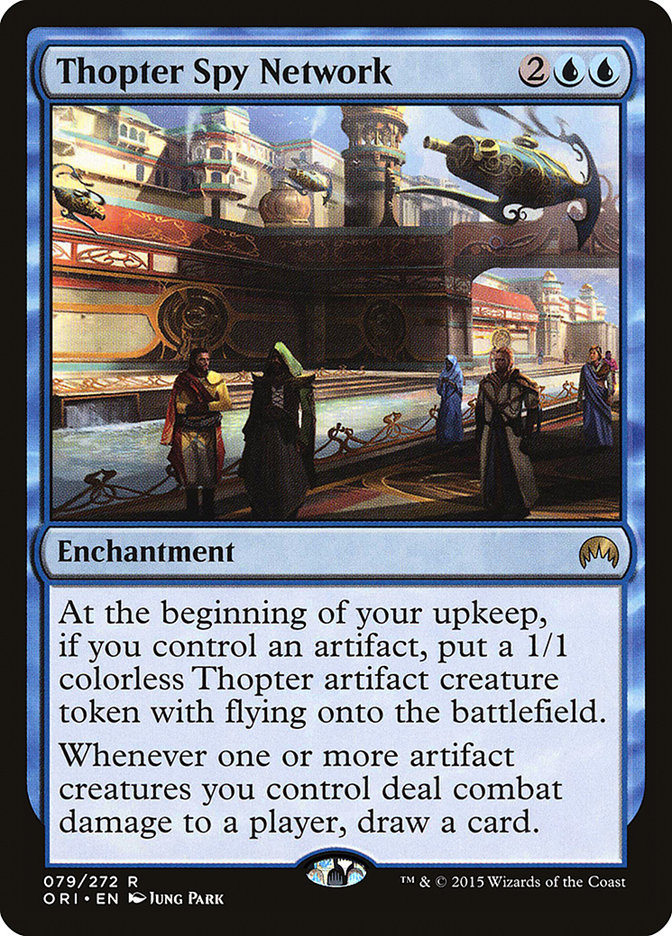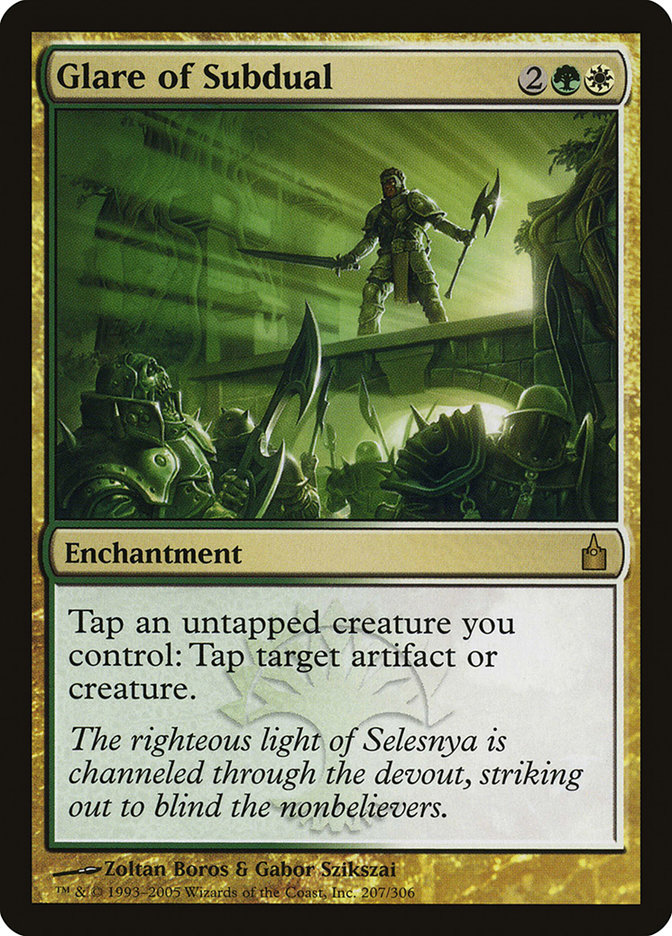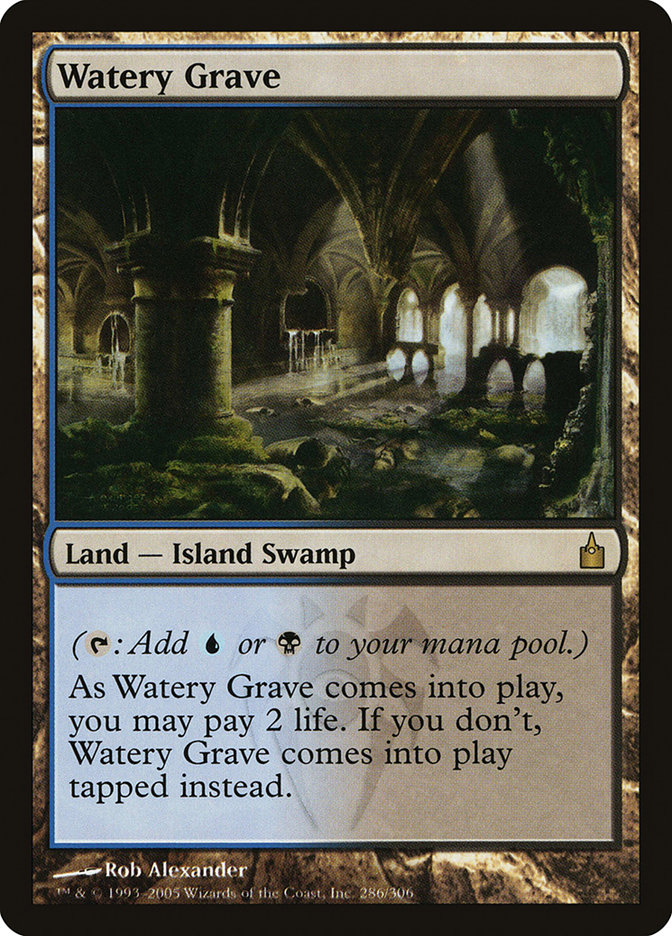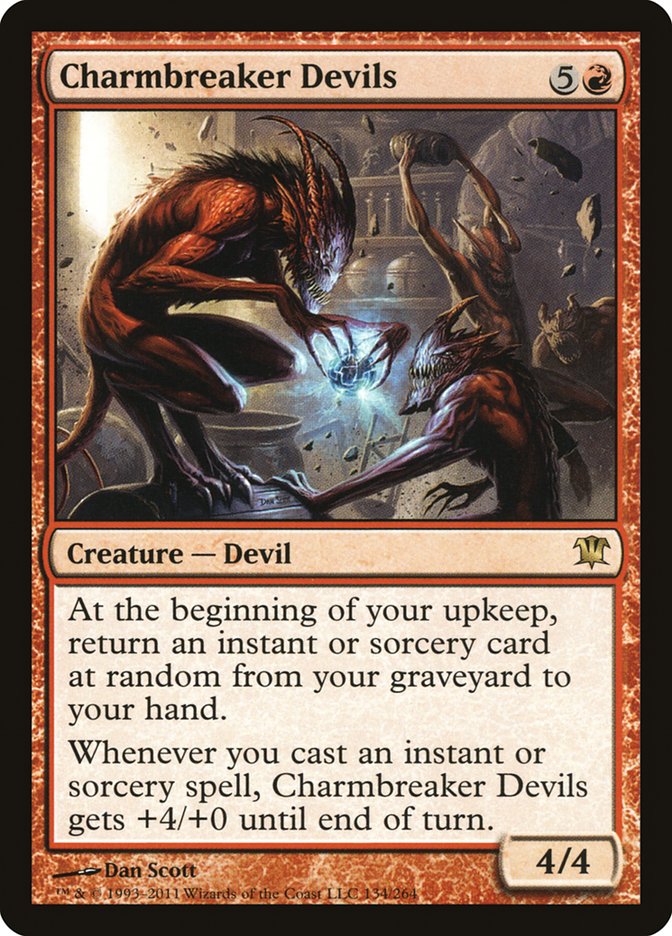15. Guildpact
It’s really hard to take the original Ravnica block as anything but one cohesive work because of how it was structured, so more on this set a bit later.
14. Exodus
Exodus wasn’t just the end of the first and most effective attempt at storytelling with Magic sets (thought it certainly was that). It was also a hotbed of cards that we now take for granted: Oath of Druids, Carnophage, Recurring Nightmare, Wood Elves, and so forth.
And for the love of all that’s good and pure, this was the first set with color-coded expansion symbols for rarity! Do you have any idea how ridiculous it felt reading cards and scouring magazines to figure out which of the cards in the pack you just bought were supposed to be the cool ones?
13. Dissension
I love it when a plan comes together. See Guildpact.
12. Sixth Edition
The stack. No, really, The. Stack.
It annoys me to this day that one of the game’s most central functions doesn’t actually appear in card text almost ever, but I also recall how absurdly convoluted it was to have mana sources, interrupts, and instants when all of them were essentially the same function.
Whoever cleaned that mess up, we all owe you.
The old “Last In, First Out” mantra isn’t just a clumsy and antiquated Magic guideline; it’s also a great way to lose your job.
This also had a nice even 350 cards. Before this, sets really just had…you know, whatever number. Cohesion is a huge part of keeping an inaccessible game accessible. Complete cycles, symmetry, design eloquence. This set was an enormous step forward for products aimed at anchoring the game down while other expansions moved toward the game’s extremes.
If we didn’t think having these types of sets was important before, we most assuredly should now.
11. Beta/Revised
Curveball!
It’s really silly to sort out the first several base sets. They’re all incredibly similar. If you take away the borders and the templating, they’re almost the same Magic set. Unlimited essentially is Beta, Beta is Alpha with all the cards included, and Revised is a cleaned up non-power version with a few Arabian Nights cards injected. Ultimately, which you choose to think is the better set is entirely up to mood and taste, but the fact of the matter is that what we call it is irrelevant.
Substitute the usual nomenclature here for “the first Magic set.” It’s whichever one you think it should be.
10. Magic 2010
I’m confident in saying that this was the most important Core Set since Alpha. The perfect storm of accessibility and nostalgia, this dovetailed with the Magic Duels releases and acted as a giant invitation to people who’ve never played and people who hadn’t played in years.
It now seems silly to think about Core Sets not being worth the hassle. I admit that it’s easy to look at it in hindsight and look at the data…but when I think back to how good Magic 2010 was for the game, now it just seems idiotic.
9. Return to Ravnica
One of the interesting things about Ravnica as a world is that it frequently re-establishes color identities that have been muddled elsewhere. That’s Ravnica’s real achievement, isn’t it? Taking the well-worn and demonstrating it in a new way.
The big takeaway from this set is that Magic’s planes aren’t just settings; they’re characters. In fact, they’re often the most important character in the story. We don’t really care that much about Jace or whatever the Maze nonsense was; what we care about is how all these “less important” cards and characters hang together to form a world that you don’t have to explain. Ravnica has never needed a supervillain or definitive hero. Most Magic sets under the new guard are like superhero movies. Ravnica is like Game of Thrones. Have you ever tried to watch a comic-book-hero movie after watching a few episodes of Game of Thrones? It’s like walking out of a college lecture into a kindergarten fingerpainting mess.
And yeah, Ravnica’s former brilliance adjusted for more current development philosophies plays pretty well. Weird, I know.
8. Rise of the Eldrazi
Before Emrakul, the Aeons Torn, the largest power and toughness for a creature had been Krosan Cloudscraper, a dopey and awkward Legions bulk rare. The scaling in Eldrazi Monument and the strange Eye of Ugin card were the only hints at what was coming, which is a really nice contrast to Emrakul’s most recent version, which was telegraphed so hard that my grandmother, having never heard of Magic, asked if I knew about it. Magic deserved a better monster, and it got it.
It’s also my favorite mothership reveal, but I won’t link you to it because I’m fairly sure it no longer works. Symbolism or something.
7. Shards of Alara
I’m starting to think that maybe having mechanics that are unique to a set of color combinations make for really good drafting.
Shards of Alara kicked off the mythic rarity, and although that puts some people off, I think it’s been a net positive. It’s easy to forget how much more expensive traditional rares used to be.
Magic Online powers that be: get this back to me now in Flashback draft form. If you haven’t done it before, I’m telling you, this is drafting nirvana.
6. Mirage
So many of Magic’s understood rules for design and development came out of this set. In addition to being a hub for all sorts of random Eternal mainstays, it’s also the first real Draft set and the kickoff of intricate contemporary combo deck design.
The set is also a good glimpse into the benefits of the game being as niche as it is. It’s hard to imagine a set with the beautiful imagery of Mirage making it past the brainstorming meeting of a game of a much bigger size.
I’ll leave it at that.
5. Urza’s Saga
Let’s get the obvious out of the way: The “this isn’t about power level” sword has two edges. Obviously, this set was a development mess. But it was also early in the game, and no other set had the development lessons (at least, no other set should’ve) that this one did. And what was going on in the meantime? Well, players were really excited. Not every card in the set is Tolarian Academy, but just about every card felt like Tolarian Academy. There are tons of cards in this set that have very simple templating and ideas that were actively fun to open and to play with, regardless of how much of a debacle Standard was. If you take out Tolarian Academy, Yawgmoth’s Will, and even go a step further to Time Spiral and Gaea’s Cradle, you still have a set with fair cards, like Catastrophe, that players genuinely were excited to get every time.
When a set is equally exciting whether or not you open the broken rare or the not-broken rare, you have something excellent. Just don’t open Brand or Rune of Protection: Lands. Oh, and Shivan Gorge. Red got hosed in this cycle.
4. Future Sight
If sets like Mirrodin were the confirmation that Magic will be around a long time, Future Sight was the hope that it’d be around forever. There isn’t anger without fear, and nearly every complaint the game receives is born from the fear that someday there will exist a world where Magic isn’t made anymore. This set did an amazing job of showing just how much room there was to grow: card frames, card types, new win and loss conditions. This set was unbelievably fascinating and intriguing because it was a gateway to the game’s potential and its, well, future.
3. Magic Origins
It didn’t have the Big Bang effect of Alpha, it didn’t have the bridge between generations of Magic 2010, and it didn’t clean up a bunch of rules like Sixth Edition did, but for my money this is the single best-crafted Core Set Magic has ever seen. It had fun mechanics, a preview of worlds to come, a look back at former worlds, endless enjoyment for new players and older players. If I had a friend who hadn’t played since college but had mastered the game then, and also someone who never got into card games, and they both wanted to play some Magic? I know exactly which packs I’d buy.
The Core Sets to come should start here and work their way forward, if that’s even possible.
2. Ravnica: City of Guilds
A lot of players had their attention captivated by Mirrodin and its big Magic update for the next generation of the game. For about fifteen minutes. Then they turned right back around.
Magic needed a home run after Mirrodin mess, and it got it. Modern, Magic’s most popular format currently, revolves around the lands designed for this block. They’re a perfect balance of stability, risk, reward, and interaction. Getting manabases together before Ravnica was always the last step in the deckbuilding process. Imagine, lands so cool that you wanted to get them first!
The Draft format is looked upon a little more highly than it probably should be, but the set is still beloved for countless other reasons. Everyone who designs or develops Magic cards for a living should be required to write a page on why Ravnica mattered so much and why every single screw-up a card or format has could easily be avoided if somebody just took the time to look back at Ravnica and the sets that followed it. It’s the gold standard of Magic.
1. Innistrad
The biggest tragedy for Magic isn’t that it’ll go away some day (what won’t?); it’s that, when it does, a majority of the people who played it will have judged it without having played with cards from Innistrad.
I’ll now critique everything wrong with this set:
- Delver of Secrets probably should’ve been a 2/2 or a 3/1.
- All the sets that came after it forced us to stop playing with it and move on.
I don’t want to move on!
If I sit here and tell you everything that’s great and correct and incredible about this set of cards, this series will drag into fifteen more parts.
Blam-o!
Well, we did it. So what do we do now?
We wait for the next Innistrad, that’s what.





